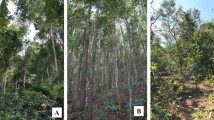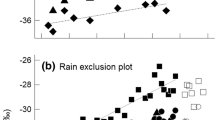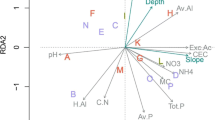Abstract
Water availability is a principal factor limiting the distribution of closed-canopy forest in the seasonal tropics, suggesting that forest tree species may not be well adapted to cope with seasonal drought. We studied 11 congeneric species pairs, each containing one forest and one savanna species, to test the hypothesis that forest trees have a lower capacity to maintain seasonal homeostasis in water relations relative to savanna species. To quantify this, we measured sap flow, leaf water potential (ΨL), stomatal conductance (g s), wood density, and Huber value (sapwood area:leaf area) of the 22 study species. We found significant differences in the water relations of these two species types. Leaf area specific hydraulic conductance of the soil/root/leaf pathway (G t) was greater for savanna species than forest species. The lower G t of forest trees resulted in significantly lower ΨL and g s in the late dry season relative to savanna trees. The differences in G t can be explained by differences in biomass allocation of savanna and forest trees. Savanna species had higher Huber values relative to forest species, conferring greater transport capacity on a leaf area basis. Forest trees have a lower capacity to maintain homeostasis in ΨL due to greater allocation to leaf area relative to savanna species. Despite significant differences in water relations, relationships between traits such as wood density and minimum ΨL were indistinguishable for the two species groups, indicating that forest and savanna share a common axis of water-use strategies involving multiple traits.




Similar content being viewed by others
Change history
05 January 2019
The original version of this article unfortunately contained a mistake. The Electronic supplementary material (ESM)?was accompanying this article by mistake.
05 January 2019
The original version of this article unfortunately contained a mistake. The Electronic supplementary material (ESM)��was accompanying this article by mistake.
05 January 2019
The original version of this article unfortunately contained a mistake. The Electronic supplementary material (ESM)��was accompanying this article by mistake.
05 January 2019
The original version of this article unfortunately contained a mistake. The Electronic supplementary material (ESM)��was accompanying this article by mistake.
05 January 2019
The original version of this article unfortunately contained a mistake. The Electronic supplementary material (ESM)��was accompanying this article by mistake.
References
Ackerly D (2004) Functional strategies of chaparral shrubs in relation to seasonal water deficit and disturbance. Ecol Monogr 74:25–44
Adejuwon JO, Adesina FA (1992) The nature and dynamics of the forest-savanna boundary in south-western Nigeria. In: Furley PA, Procter J, Ratter JA (eds) Nature and dynamics of the forest-savanna boundaries. Chapman and Hall, London, pp 331–352
Bhaskar R, Valiente-Banuet A, Ackerly DD (2007) Evolution of hydraulic traits in closely related species pairs from Mediterranean and non-Mediterranean environments of North America. New Phytol 176:718–726
Bond WJ (2008) What limits trees in C-4 grasslands and savannas? Annu Rev Ecol Evol Syst 39:641–659
Bowman DMJS (2000) Australian rainforests: islands of green in a land of fire. Cambridge University Press, Cambridge
Bucci SJ, Goldstein G, Meinzer FC, Scholz FG, Franco AC, Bustamante M (2004) Functional convergence in hydraulic architecture and water relations of tropical savanna trees: from leaf to whole plant. Tree Physiol 24:891–899
Bucci SJ, Goldstein G, Meinzer FC, Franco AC, Campanello P, Scholz FG (2005) Mechanisms contributing to seasonal homeostasis of minimum leaf water potential and predawn disequilibrium between soil and plant water potential in Neotropical savanna trees. Trees Struct Funct 19:296–304
Castro EA, Kauffman JB (1998) Ecosystem structure in the Brazilian cerrado: a vegetation gradient of aboveground biomass, root mass and consumption by fire. J Trop Ecol 14:263–283
Castro-Diez P, Villar-Salvador P, Perez-Rontome C, Maestro-Martinez M, Montserrat-Marti G (1998) Leaf morphology, leaf chemical composition and stem xylem characteristics in two Pistacia (Anacardiaceae) species along a climatic gradient. Flora 193:195–202
da Silva MC Jr, Furley PA, Ratter JA (1996) Variations in tree communities and soils with slope in gallery forest, Federal District, Brazil. In: Anderson MG, Brooks SM (eds) Advances in hillslope processes, vol 1. Wiley, Chichester, pp 451–469
Davis SD, Ewers FW, Sperry JS, Portwood KA, Crocker MC, Adams GC (2002) Shoot dieback during prolonged drought in Ceanothus (Rhamnaceae) chaparral of California: a possible case of hydraulic failure. Am J Bot 89:820–828
Durigan G, Ratter JA (2006) Successional changes in cerrado and cerrado/forest ecotonal vegetation in western Sao Paulo State, Brazil, 1962–2000. Edinb J Bot 63:119–130
Enquist BJ, West GB, Charnov EL, Brown JH (1999) Allometric scaling of production and life-history variation in vascular plants. Nature 401:907–911
Felfili JM, da Silva MC Jr (1992) Floristic composition, phytosociology and comparison of cerrado and gallery forests at Fazenda Agua Limpa, Federal District, Brazil. In: Furley PA, Proctor J, Ratter JA (eds) Nature and dynamics of the forest-savanna boundaries. Chapman and Hall, London, pp 393–416
Gartner BL, Meinzer FC (2005) Structure-function relationships in sapwood water transport and storage. In: Zwieniecki M, Holbrook NM (eds) Vascular transport in plants. Elsevier/Academic Press, Oxford, pp 307–331
Granier A (1985) A new method of sap flow measurement in tree stems. Ann Sci For 42:193–200
Granier A (1987) Evaluation of transpiration in a Douglas-fir stand by means of sap flow measurements. Tree Physiol 3:309–319
Hao GY, Hoffmann WA, Scholtz FG, Bucci SJ, Meinzer FC, Franco AC, Cao KF, Goldstein G (2008) Stem and leaf hydraulics of congeneric tree species from adjacent tropical savanna and forest ecosystems. Oecologia 155:405–415
Hennenberg KJ, Goetze D, Kouame L, Orthmann B, Porembski S (2005) Border and ecotone detection by vegetation composition along forest-savanna transects in Ivory Coast. J Veg Sci 16:301–310
Hoffmann WA, Franco AC (2003) Comparative growth analysis of tropical forest and savanna woody plants using phylogenetically independent contrasts. J Ecol 91:475–484
Hoffmann WA, Orthen B, Nascimento PKV (2003) Comparative fire ecology of tropical savanna and forest trees. Funct Ecol 17:720–726
Hoffmann WA, Orthen B, Franco AC (2004) Constraints to seedling success of savanna and forest trees across the savanna-forest boundary. Oecologia 140:252–260
Hoffmann WA, Franco AC, Moreira MZ, Haridasan M (2005) Specific leaf area explains differences in leaf traits between congeneric savanna and forest trees. Funct Ecol 19:932–940
Hoffmann WA, Adasme R, Haridasan M, Carvalho M, Geiger EL, Pereir MAB, Gotsch SG, Franco AC (2009) Tree topkill, not mortality, governs the dynamics of alternate stable states at savanna-forest boundaries under frequent fire in central Brazil. Ecology 90(5):1326–1337
Kelley G, O’Grady AP, Hutley LB, Eamus D (2007) A comparison of tree water use in two contiguous vegetation communities of the seasonally dry tropics of northern Australia: the importance of site water budget to tree hydraulics. Aust J Bot 55:700–708
Lundblad M, Lagergren F, Lindroth A (2001) Evaluation of heat balance and heat dissipation methods for sap flow measurements in pine and spruce. Ann For Sci 58:625–638
Meinzer FC (2003) Functional convergence in plant responses to the environment. Oecologia 134:1–11
Meinzer FC, Goldstein G, Franco AC, Bustamante M, Igler E, Jackson P, Caldas L, Rundel PW (1999) Atmospheric and hydraulic limitations on transpiration in Brazilian cerrado woody species. Funct Ecol 13:273–282
Meinzer FC, Johnson DM1, Lachenbruch B, McCulloh KA, Woodruff DR (2009) Xylem hydraulic safety margins in woody plants: coordination of stomatal control of xylem tension with hydraulic capacitance. Funct Ecol 23:922–930
Myster RW, Walker LR (1997) Plant successional pathways on Puerto Rican landslides. J Trop Ecol 13:165–173
Nepstad DC, Decarvalho CR, Davidson EA, Jipp PH, Lefebvre PA, Negreiros GH, Dasilva ED, Stone TA, Trumbore SE, Vieira S (1994) The role of deep roots in the hydrological and carbon cycles of Amazonian forests and pastures. Nature 372:666–669
O’Grady AP, Cook PG, Eamus ED, Duguid A, Wischusen JDH, Fass T, Worldege D (2009) Convergence of tree water use within an arid-zone woodland. Oecologia 160:643–655
Oliveira RS, Bezerra L, Davidson EA, Pinto F, Klink CA, Nepstad DC, Moreira A (2005) Deep root function in soil water dynamics in cerrado savannas of central Brazil. Funct Ecol 19:574–581
Oliveira-Filho AT, Ratter JA (1995) A study of the origin of central Brazilian forests by the analysis of plant species distribution patterns. Edinb J Bot 52:141–194
Rossatto DR, Hoffmann WA, Franco AC (2009) Differences in growth patterns between co-occurring forest and savanna trees affect the forest–savanna boundary. Funct Ecol 23:689–698
San José JJ, Fariñas MR (1991) Temporal changes in the structure of a Trachypogon savanna protected for 25 years. Acta Oecol 12:237–247
Soltis P, Soltis D, Edwards C (2005) Angiosperms. Flowering plants. Version 3 June 2005. http://tolweb.org/Angiosperms/20646/2005.06.03 In: the Tree of Life web project, http://tolweb.org/
Stratton L, Goldstein G, Meinzer FC (2000) Stem water storage capacity and efficiency of water transport: their functional significance in a Hawaiian dry forest. Plant Cell Environ 23:99–106
Tang G, Bartlein P (2008) Simulating the climatic effects on vegetation: approaches, issues and challenges. Prog Phys Geogr 5:543–556
Tyree MT, Snyderman DA, Wilmot TR, Machado JL (1991) Water relations and hydraulic architecture of a tropical tree (Schefflera-Morototoni)—data, models, and a comparison with 2 temperate species (Acer-Saccharum and Thuja-Occidentalis). Plant Physiol 96:1105–1113
Westoby M, Falster DS, Moles AT, Vesk PA, Wright IJ (2002) Plant ecological strategies: some leading dimensions of variation between species. Annu Rev Ecol Syst 33:125–159
Acknowledgments
We thank IBGE for logistical support; Bruna Diniz, Marina Carvalho, Mirea A. B. Pereira, Inaldo Araujo, Kristen Mckinley and Palmyra Romeo for assistance in the field; and Renee Marchin, On Lee Lau, Alice Wines and Wade Wall and three anonymous reviewers for comments on this manuscript. This material is based on work supported by the National Science Foundation under grant no. DEB-0542912, the A. W. Mellon Foundation, and CNPq, Brazil.
Author information
Authors and Affiliations
Corresponding author
Additional information
Communicated by Ram Oren.
Electronic supplementary material
Below is the link to the electronic supplementary material.
Rights and permissions
About this article
Cite this article
Gotsch, S.G., Geiger, E.L., Franco, A.C. et al. Allocation to leaf area and sapwood area affects water relations of co-occurring savanna and forest trees. Oecologia 163, 291–301 (2010). https://doi.org/10.1007/s00442-009-1543-2
Received:
Accepted:
Published:
Issue Date:
DOI: https://doi.org/10.1007/s00442-009-1543-2




